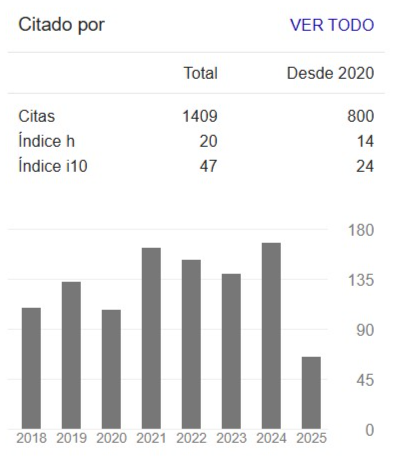El espacio en José Luis Pardo y la redefinición del objeto de la estética
DOI:
https://doi.org/10.54104/nodo.v17n33.1371Palabras clave:
ciudad, espacio, estetogramas, imagen, tiempoResumen
En el presente artículo desarrollamos la noción de espacio en la propuesta estética de José Luis Pardo. Para ello nos basamos en dos de sus textos principales en donde plantea dicho concepto: Sobre los espacios. Pintar, escribir, pensar y Las formas de la exterioridad. Allí encontramos que Pardo propone una redefinición del objeto de la estética desde lo bello hacia lo sensible, preguntándose cómo devenimos sensibles por medio del hábito. Su propuesta es asubjetiva o presubjetiva, es decir, tiende a poner la atención sobre el mundo antes que sobre el sujeto, puesto que el mundo mismo se individúa, posee formas de expresión (estética). La tesis principal que proponemos consiste en que el espacio es una noción fundamental para pensar una redefinición del objeto de la estética. Ya no se estudia lo bello sino lo sensible, y se parte de una perspectiva no antropocéntrica para explicar cómo los individuos surgen a partir de la sensibilidad y del hábito, y posteriormente conforman su propio territorio haciéndolo a su vez habitable.
Descargas
Citas
Casciari, H. (2008). El móvil de Hansel y Gretel. Consultado en: https://hernancasciari.com/blog/el_movil_de_hansel_y_gretel el 29 de julio de 2022.
Descartes, R. (1994). Discurso del método. Tratado de las pasiones. Barcelona: RBA Editores.
Deleuze, G. (1994). Lógica del sentido. Barcelona: Paidós.
Deleuze, G. (2002). Diferencia y repetición. Buenos Aires: Amorrortu.
Deleuze, G. & Guattari, F. (1993). ¿Qué es la filosofía? Barcelona: Anagrama.
Ferrater Mora, J. (1994). Diccionario de filosofía. Tomo II. E-J. Barcelona: Ariel.
Gadamer, H. (1998). Verdad y método II. Salamanca: Ediciones Sígueme.
Hume, D. (2014). Tratado de la naturaleza humana. Buenos Aires: FV Ediciones.
Juarroz, R. (1987). Poesía vertical, Vuelta, 123. Consultado en: https://letraslibres.com/wp-content/uploads/2016/05/Vuelta-Vol11_123_02PsVtRJz.pdf el 20/05/2022.
Leroi-Gourhan, A. (1971). El gesto y la palabra. Venezuela: Ediciones de la Biblioteca de la Universidad Central de Venezuela.
Heredia. J. M. (2011). Deleuze, von Uexküll y “la Naturaleza como música”. A Parte Rei. Revista de filosofía. Consultado en: http://serbal.pntic.mec.es/~cmunoz11/heredia75.pdf el 1/02/2021.
Heredia, J. M. (2021). El concepto uexkülliano de mundo circundante y sus desplazamientos. Universitas Philosophica, 76 (38), pp. 15-47.
Lorenz, K. (1971). Sobre la agresión: el pretendido mal. México: Siglo XXI.
Montoya, J. (2004). Aproximación al concepto analogía en la obra de Gilbert Simondon. Co-herencia, 1(1), pp. 31-50.
Parra, J. (2015) ¿Qué es un estetograma? Reflexiones en torno al devenir sensible del espacio. Revista Colombiana de Pensamiento Estético e Historia del Arte (3), pp. 63-85.
Pardo, J. (1990). Deleuze: Violentar el pensamiento. Fuenlabrada: Editorial Cincel.
Pardo, J. (1991). Sobre los espacios: pintar, escribir, pensar. Barcelona: Ediciones del Serbal.
Pardo, J. (1992). Las formas de la exterioridad. Valencia: Pre-Textos.
Platón (2003). Diálogos. Volumen V. El sofista. Obra completa en 8 volúmenes. Madrid: Gredos.
Simondon, G. (2013). Imaginación e invención. Buenos Aires: Cactus.
Simondon, G. (2014). La individuación a la luz de las nociones de forma e información. Buenos Aires: Cactus.
Von Uexküll, J. (2014). Cartas biológicas a una dama. Buenos Aires: Cactus.
Descargas
Publicado
Versiones
- 2022-11-02 (2)
- 2022-10-11 (1)
-
Resumen802
-
PDF583
Cómo citar
Número
Sección
Licencia
Derechos de autor 2022 Isabella Builes Roldán, Jorge William Montoya Santamaría

Esta obra está bajo una licencia internacional Creative Commons Atribución-NoComercial-CompartirIgual 4.0.




 Portal de Ciencia Abierta
Portal de Ciencia Abierta